
A Guide to Corkscrew Wine Openers
Shop All Corkscrews
How to Use a Wine Opener
Before reading about the types of wine openers, watch our video to learn how to use a wine key the proper way.
0:00
Types of Wine Openers
Each type of corkscrew has different advantages. While they all open wine bottles, how they are used to remove a cork varies from type to type. Depending on your wine list, you may want to consider having multiple wine opener types to remove different corks. Below are 8 types of corkscrews and how to use them to help you determine which corkscrew is best for you.
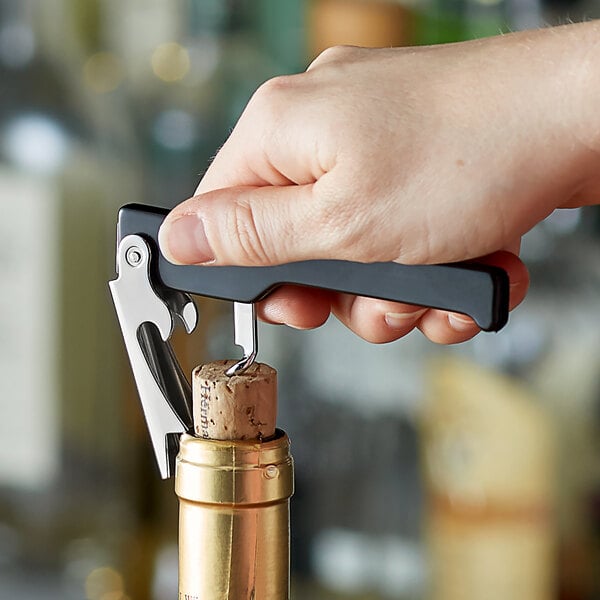
1. Wine Key
A wine key, sometimes called a waiter's corkscrew, is the traditional wine opener of choice for most establishments. They offer the perfect blend of affordability, compact size, and functionality, and they are considered to be the oldest form of opening a bottle of wine. They’re perfect for front-of-house use for servers who often open and pour wine directly at tables. Many waiter's corkscrews also include a small knife to quickly cut through the foil on a wine bottle as well as bottle cap openers. Plus, they are small enough to be put into apron pockets for convenient, immediate use.
How to Use a Wine Key:
Follow the steps below to open a wine bottle with a wine key.
- Start by cutting the foil under the lip of the bottle.
- Remove the foil from the bottle's neck.
- Place the worm on the center of the cork and twist the corkscrew to insert the worm into the cork.
- Place the first small boot lever notch on the lip of the bottle and hold it in place.
- Lever the handle up to pull the cork about halfway out of the bottle.
- Move the second boot lever notch to the tip of the bottle and pull the cork the rest of the way out of the bottle.
- To remove the cork from the worm, reverse the corkscrew motion while holding onto the cork.

2. Pocket Corkscrew
Pocket corkscrews have a compact size that's perfect for carrying in aprons or pant pockets. Many pocket corkscrews include a sheath to keep the corkscrew worm from poking through the pocket's fabric. This sheath is also often used to create a "T" shaped crossbar that provides leverage to twist the worm into the cork to remove it. These small, portable corkscrews are great for servers and bartenders to keep on hand at all times. Compared to traditional corkscrews, pocket corkscrews are more compact but they require more manual strength to remove the cork from the wine bottle and typically do not include bottle openers.
How to Use a Pocket Corkscrew:
Follow the steps below to open a wine bottle with a pocket corkscrew.
- Start by cutting the foil under the lip of the bottle.
- Remove the sheath and slide it into the opening at the base of the corkscrew.
- Insert the corkscrew into the cork and turn until the worm is inserted into the cork.
- Once the worm is fully inserted, pull outwards on the handle to remove the cork.
- To remove the cork from the worm, reverse the corkscrew motion while holding onto the cork.
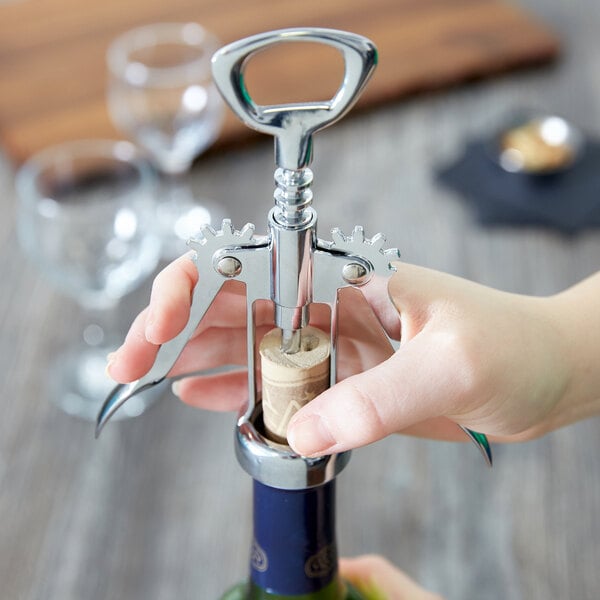
3. Wing Corkscrew
Wing, or winged, corkscrews have two levers on opposite sides, which raise with each twist of the worm into the cork and then are pushed down to remove the cork. They are a popular choice for synthetic cork removal due to their ease of use. Additionally, they can be used on corks of all sizes for further versatility. Wing corkscrews are not the best choice for opening vintage wines or wines with natural, brittle corks as they can leave cork crumbs behind. With a small size and easy-to-use design, these corkscrews are great for front-of-house use by waiters.
How to Use a Wing Corkscrew:
Follow the steps below to open a wine bottle with a wing corkscrew.
- Start by cutting the foil under the lip of the bottle.
- Cut the foil around the neck of the bottle.
- Remove the foil and insert the worm into the center of the cork.
- Twist the corkscrew lever to insert the worm into the cork. Continue twisting until the wings rise all the way up.
- Once the wings have risen, push down on them simultaneously to pull the cork out of the bottle.
- To remove the cork from the corkscrew, simply turn the handle counterclockwise.
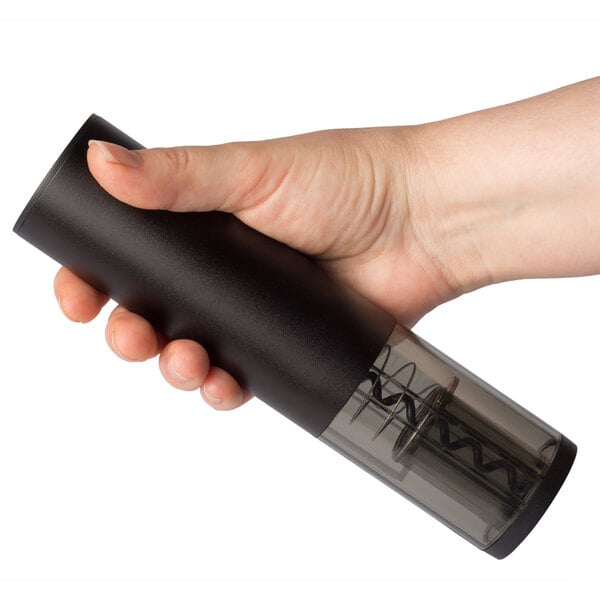
4. Electric Corkscrew
Electric corkscrews are the easiest way to open wine bottles. Their simple push-button operation makes it possible for anyone to open a bottle of wine. These corkscrews are great for back-of-house use, and for quickly opening bottles of wine behind the bar. Electric corkscrews are ideal for beginners or anyone with arthritis, carpal tunnel, or minimal hand mobility. Since they are large and bulky, electric corkscrews are not the best option for table service, where uncorking wine is just as much a part of the experience as drinking it. Be sure to keep it charged so it is always ready to use when you need it.
How to Use an Electric Corkscrew:
Follow the steps below to open a wine bottle with an electric wine opener.
- Start by cutting the foil under the lip of the bottle.
- Place the electric corkscrew on top of the wine bottle's neck. Be sure to keep the corkscrew vertical.
- Turn the corkscrew on and it will automatically insert the worm and remove the cork.
- Remove the corkscrew from the top of the bottle once the corkscrew has removed the cork.
- Reverse the corkscrew motion to remove the cork from the worm.
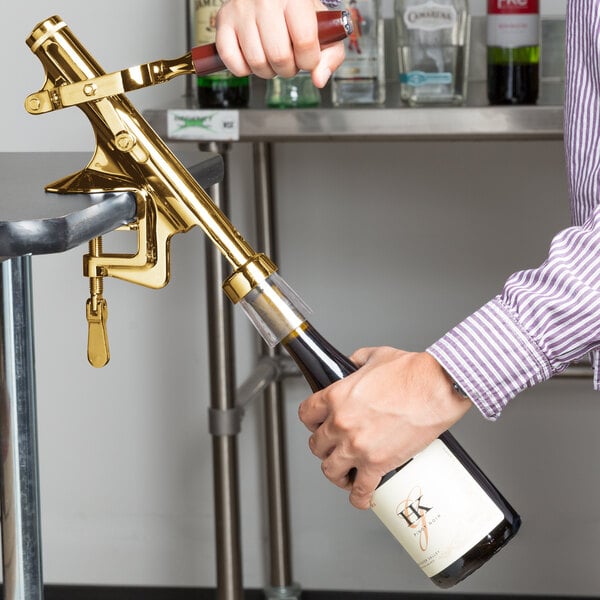
5. Mounted Wine Opener
Mounted wine openers can either be attached to a countertop or mounted to a beam or wall. Mounted wine opener corkscrews provide additional torque and can open bottles faster and with less effort than many other types of corkscrews. A wall-mount corkscrew can be set for different penetration depths. This is useful for partial wine cork extraction at banquet room functions where the wine will be placed on the tables before the event begins. These corkscrews are great for back-of-house use in high-volume settings, but, some have an upscale appearance that is perfect for enhancing the presentation of your wine room or hotel bar.
How to Use a Mounted Wine Opener:
Follow the steps below to open a wine bottle with a mounted corkscrew.
- Insert the neck of the wine bottle into the cradle.
- Pull down on the handle to insert the corkscrew.
- Return the handle to the starting position to pull the cork out.
- Once the bottle is removed from the cradle the cork will fall to the floor.
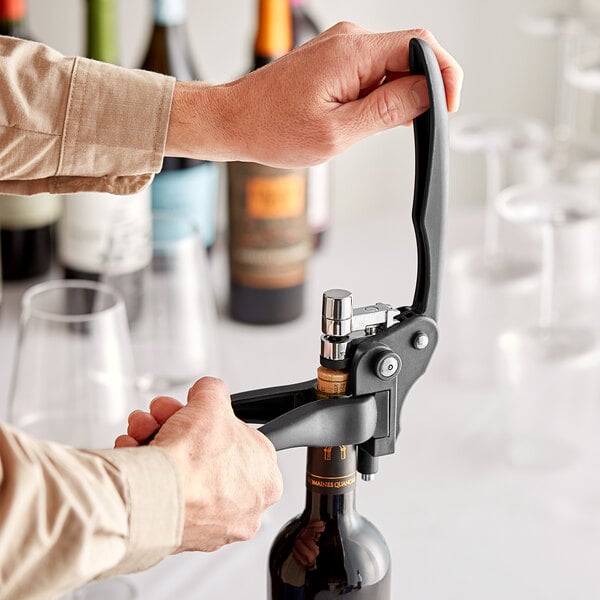
6. Lever Corkscrew
Lever corkscrews are quickly gaining popularity thanks to their ease of use. Most lever corkscrews only require two motions, one forward motion in which the worm is inserted into the cork and another that gently pulls the cork from the bottle. The real benefit of using a lever corkscrew is the amount of control they provide as the handle firmly holds the neck of the bottle while the corkscrew is in use. Plus, they do not require any manual hand or arm strength, making them great for anyone with arthritis, carpal tunnel, or minimal hand mobility. Lever corkscrews can be used to remove older corks from aged wines, however, they are not recommended for extracting synthetic corks.
How to Use a Lever Corkscrew:
Follow the steps below to open a wine bottle with a lever corkscrew.
- Remove the foil from the bottle's neck.
- With the lever in the up position, place the corkscrew on top of the wine bottle.
- Push the lever down to insert the worm into the cork.
- Once the lever is all the way down, pull the handle back up to remove the cork from the wine bottle.
- To remove the cork from the worm, lift the corkscrew off the bottle and flip the handle up and down a few times.
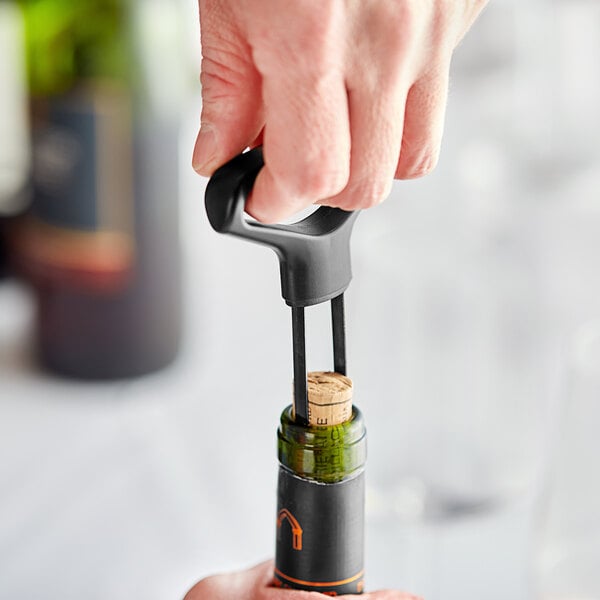
7. Wine Cork Extractor
Wine cork extractors feature prongs that slide down between the wine bottle and the cork to remove the cork from the bottle. Compared to other corkscrew types, wine cork extractors take more manual strength to extract the cork. They're ideally used with vintage corks made from natural cork. Extractors won't damage vintage wine corks or cause them to break apart and drop crumbs into the wine, allowing you to reseal the bottle as soon as you're done pouring. Due to their small size, these extractors are great for keeping behind the bar or in aprons for quick, convenient access.
How to Use a Wine Cork Extractor:
Follow the steps below to open a wine bottle with a wine cork extractor.
- Start by cutting the foil under the lip of the bottle.
- Firmly holding the neck of the bottle, slide the extractor prongs between the cork and the inside of the neck.
- Shimmy the prongs down using a left-to-right motion while applying light force to the handle.
- Once fully inserted, twist the extractor and pull upward to remove the cork.
- To remove the cork from the extractor simply slide it out from between the prongs.
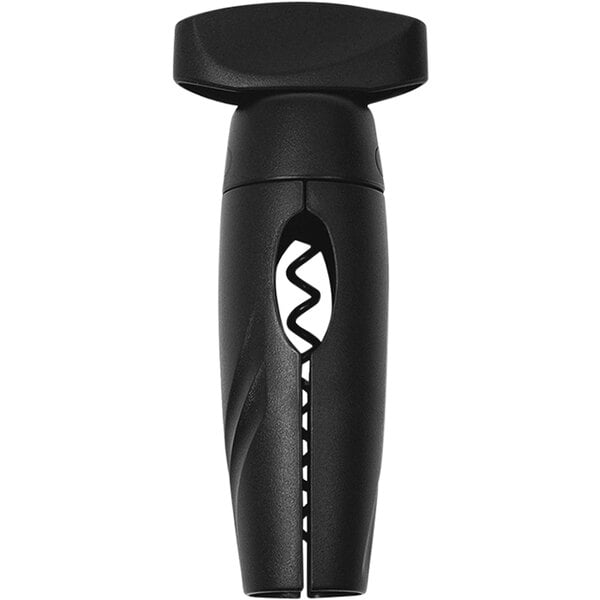
8. Continuous Pull Corkscrew
Continuous pull corkscrews typically feature a two-piece construction and work by using a twist motion to drive the worm into the cork. The prongs or base of the corkscrew sit on the neck of the bottle, and many styles have hinges on the handles so you can squeeze them around the bottle's neck to get a better grip. Due to their small size and easy-to-use design, these corkscrews are great for front-of-house use by servers and bartenders.
How to Use a Continuous Pull Corkscrew:
Follow the steps below to open a wine bottle with a continuous pull corkscrew.
- Start by cutting the foil under the lip of the bottle.
- Place the base of the corkscrew over the top of your wine bottle.
- Turn the handle clockwise to insert the worm into the cork.
- As the worm screws into the cork, slide the sides over the neck of the bottle for a better grip.
- Continue turning the handle clockwise until the cork is fully extracted.
- To remove the cork from the corkscrew, simply turn the handle counterclockwise.
What to Consider When Purchasing a Corkscrew
Below are some factors to consider when you are browsing for the perfect new corkscrew.
Ease of Use
The first thing to take into consideration when purchasing a wine opener or corkscrew is its ease of use. A corkscrew that is hard to use may result in cork crumbs in the wine, broken corks, or you may end up unable to remove the cork. Because of this, many large operations have moved towards counter-mount, wall-mount, or electric corkscrews as these styles make cork removal incredibly easy for everyone.
Cost
Smaller operations or establishments with sommeliers may opt for a pocket or waiter's corkscrew. These corkscrews are generally less expensive than other styles and are inexpensive to replace. Large, high-volume operations should consider the more expensive wall-mount, counter-mount, and electric corkscrews as these styles make opening many bottles at a time a quick and easy task, which helps recoup their cost in saved labor.
Size
Smaller corkscrews, such as waiter's and pocket corkscrews, are a great choice for staff on the move. These corkscrews easily fit inside an apron or pants pocket and are lightweight. Larger corkscrews, such as electric, counter-mount, and wall-mount corkscrews, are better suited for a single location where staff can carry wine bottles to the corkscrew to open them.
Cork Type
Different types of corkscrews excel at removing different types of cork. To start, there are two types of wine corks: synthetic and natural cork. Synthetic corks are denser than natural corks, which requires more force to twist the worm into the cork. The advantage of synthetic corks is that they are less likely to break apart during extraction. Natural corks are more brittle and sensitive to removal than synthetic corks. The advantage of natural corks is that they properly age wines stored over long periods of time.
Type of Restaurant
Upscale restaurants that emphasize the presentation of wines may want to go for a decorative or vintage-style corkscrew because of the enhanced presentation value these corkscrews provide. Large banquet halls, wedding venues, or wine tasting rooms that may be opening a lot of wine bottles in a short amount of time will want to consider a wall-mount or counter-mount corkscrew for speed and ease of use. Lastly, restaurants that only serve wine occasionally may want to consider a wing or waiter's corkscrew simply from a cost standpoint.
Parts of a Corkscrew
Despite there being different corkscrew types, corkscrews generally have the same parts, like a corkscrew worm, handle, and bootlever, to remove corks. Additional features, such as foil cutters and bottle cap removers, are also common components found on corkscrews.

- Corkscrew worm: A single metal helix that drives into a wine cork to remove it from the bottle. The helix grabs the cork as it is twisted in so that the cork can be fully removed from the wine bottle.
- Corkscrew handle: Provides the leverage and grip necessary to remove corks from the wine bottle. Handle styles, lengths, and materials vary greatly across the different types of corkscrews.
- Corkscrew bootlever: Provides additional leverage to pull wine corks out of wine bottles. Bootlevers are primarily found on waiter's corkscrews.
- Foil cutter: Generally small, serrated blades or wheels that are used to slice open the protective foil covering at the top of the wine bottle.
- Bottle cap remover: Transforms a corkscrew from simply being able to open wine to popping the tops off beer or soda bottles. Bottle cap removers are available on many styles of corkscrews.
Wine Opener FAQ
Read on to learn the answers to some frequently asked questions about wine openers.
What Type of Corkscrew Is Best for Removing Synthetic Corks?
A wing corkscrew is an excellent choice for removing synthetic corks. They provide more leverage than other types of corkscrews to make tight-fitting synthetic corks easier to remove.
What Type of Corkscrew Is Best for Removing Natural Corks?
Natural corks can become sensitive or brittle with age. Therefore, if you're opening a lot of vintage wines, a wine opener extractor or lever corkscrew are great options. These types of corkscrews are less likely to break a cork apart leaving cork crumbs in your wine.
How Do I Get a Broken Cork Out of a Wine Bottle?
Consider using a cork retriever. Simply hold the prongs together, insert the device into your bottle, and push down on the top to open the prongs. Once the prongs are situated around the cork, pull up on the handle. The prongs will close automatically around the cork, pulling it to safety outside the bottle and saving your beverage.
Related Resources

Types of Wine Glasses
Whether sweet or dry, white or red, robust or light, wine requires precise serving procedures to reach its full flavor potential. Mastering the art of serving and pouring wine and holding the glass correctly creates a positive experience for wine enthusiasts and first-time wine tasters alike. In addition to proper serving temperatures, each type of wine requires a specific style of glass for service to best enhance the aromas, flavors, and overall experience of the wine. To best enjoy your wine collection, browse through the links below to choose the ideal wine glass for your needs. Shop All Wine Glasses Use the following links to learn more about different types of wine glasses: Red Wine Glasses White Wine Glasses Red Wine Glasses Burgundy

Everything You Should Know about Decanting Wine
Decanting wine is a technique used to enhance wine's properties by allowing it to breathe and separating any sediment. Properly performing this method positively impacts the natural flavors of wine and creates an enjoyable experience for wine tasters . This comprehensive guide provides the steps to decant wine and explores the different types of wine decanters for everything on your wine list . Shop All Wine Decanters

Proper Wine Storage Tips
Whether you need to properly store the most popular wines for your restaurant or you're looking for long-term wine storage tips, there are a few things to always remember. Take into consideration important factors such as temperature, humidity, and air or light exposure. Additionally, it's important to know the proper wine storage temperature for reds, whites, and everything in between. If you don't have a designated sommelier in your restaurant, be sure to follow the tips below to get the most out of your wine reserves. Shop All Wine Racks and Shelves How to Use a Wine Cooler Learn how to store wine in a wine cooler. Wine coolers keep wine bottles at the ideal temperature. All you have to do is load them properly and place them in the idea
- Topics 1346
- Industrial 55
- Troubleshooting Guides 21
- Restaurant Management 128
- Bar Management 55
- Catering Tips 35
- Bakery Management 42
- Food Trucks & Concessions 49
- Advertising & Marketing 37
- Eco-Friendly Tips 11
- Facility Layout & Design 41
- Coffee Shop Tips 28
- Installation & Maintenance 51
- Janitorial & Pest Control 30
- Safety & Sanitation 88
- Startup Tips 104
- Menu Design 10
- Kitchen & Cooking Tips 81
- Hospitality Management 23
- Pizza & Sandwich Shop Tips 36
- Smallwares 37
- Food Prep 88
- Tabletop Items 17
- Disposables 22
- Calculators & Tools 6
- Consumables 52
- Warewashing & Laundry 18
- Cooking Equipment 90
- Food Storage & Refrigeration 51
- Beverage Equipment 34
- Office Supplies 6
- Resource Type
- In-Depth Articles272
- Buying Guides296
- How-Tos93
- Product Reviews77


